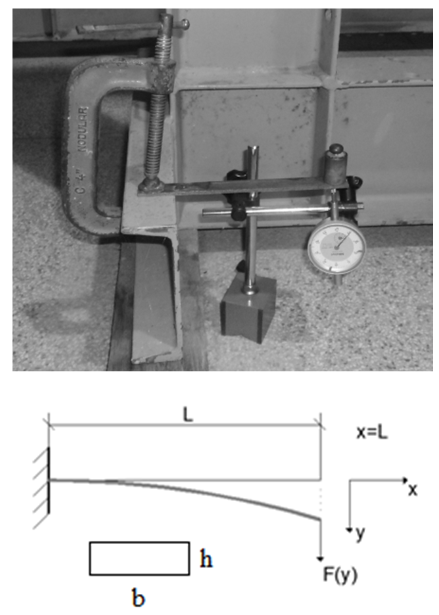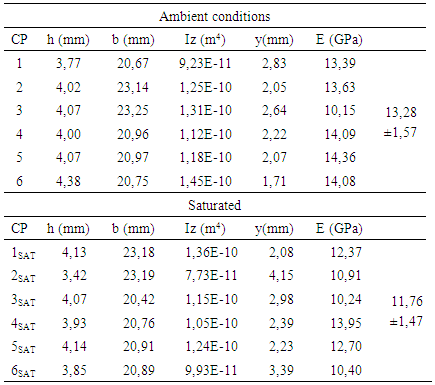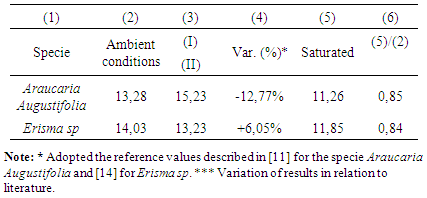-
Paper Information
- Paper Submission
-
Journal Information
- About This Journal
- Editorial Board
- Current Issue
- Archive
- Author Guidelines
- Contact Us
International Journal of Materials Engineering
p-ISSN: 2166-5389 e-ISSN: 2166-5400
2016; 6(3): 103-106
doi:10.5923/j.ijme.20160603.07

Contribution to the Development of a Method for Assessment of Modulus of Elasticity (E) of Timber Structures by Non-destructive Tests
Scremim Cristofer Bernardi, Penner Elisabeth
Federal University of Technology, Curitiba, Brazil
Correspondence to: Scremim Cristofer Bernardi, Federal University of Technology, Curitiba, Brazil.
| Email: |  |
Copyright © 2016 Scientific & Academic Publishing. All Rights Reserved.
This work is licensed under the Creative Commons Attribution International License (CC BY).
http://creativecommons.org/licenses/by/4.0/

In restructuring and restoration of timber structures, it’s necessary to evaluate the integrity of the structural elements, especially mechanical properties. For this study, two types of wood were used; a dicotyledonous - Erismasp and a conifer - AraucariaAugustifolia. This study purposes an alternative methodology for determining the modulus of elasticity (E) with non-destructive tests in reduced samples. The proposed methodology helps in the productivity and execution of tests, respecting the parameters of the Brazilian standard NBR 7190:1997. The simple flexion tests in reduced models provide compatible values with the required by the Brazilian standard, being an additional tool to evaluate new and old structures.
Keywords: Non-Destructive testing, Structural assessment, Timber structures
Cite this paper: Scremim Cristofer Bernardi, Penner Elisabeth, Contribution to the Development of a Method for Assessment of Modulus of Elasticity (E) of Timber Structures by Non-destructive Tests, International Journal of Materials Engineering , Vol. 6 No. 3, 2016, pp. 103-106. doi: 10.5923/j.ijme.20160603.07.
Article Outline
1. Introduction
- Wood is one of the oldest construction materials [1]. However, the information about the integrity of structural elements, in the process of restoring a timber structure, is rarely available. The way to determine mechanical properties of the elements of a building can be a challenge for professionals, because the complexity of wood, which is biodegradable, hygroscopic and anisotropic. Obtaining this information can determinate the success of the intervention [1, 2]. Several studies have searched the determination of the modulus of elasticity (E) by non-destructive testing, in timber beams and as small specimens [3-9].Visual inspection combined with a structural diagnosis of wood is a preliminary step in the process of preservation of assets. Principles for the conservation of historic timber structures were confirmed at the International Wood Committee, 1993 document of ICOMOS (International Council on Monuments and Sites), which recommends an accurate and thorough diagnosis of the causes and effects of degradation. A diagnosis should precede any intervention and should be grounded on documentary evidence from a site inspection and, if necessary, by determining the physical causes and nondestructive testing results [10].The standard [11] establishes modification coefficients, which are responsible for adjusting the calculated resistance values as a function of some parameters that are not considered by the safety coefficient. These coefficients consider the class of the loading, humidity and quality of material used. These criteria require the designer to adopt more robust elements, which leaves less workable use of wood as a base less attractive, compared to other materials such as steel or concrete.For flexion tests, the standard [11] suggests the use of a lot of raw material and a more complex processing, a factor that makes difficult the implementation of such tests. The test can be realized for two forms: 3 or 4 support points, with variable dimensions for the specimens [11-13].The standard [12] recommends using specimens with large dimensions similar to real conditions of structural members to make visible the defects of wood. The standard [13] proposes the use of smaller specimens, which facilitates test execution.The modification coefficients affect the design values of the properties of wood due to some parameters not covered. In the standard [11] the coefficient of kmod,2 evaluates the humidity class and the type of material used in construction. For the purpose of this study the values of kmod,2 range or vary from 0.8 to 1.0 according the humidity class, and for the complete saturation of the element must be considered the value 0.65.The objective of this research is to present an alternative methodology to determine the modulus of elasticity (E) by non-destructive tests on specimens of small size and check the compatibility of the relationship suggested by the standard [11] when it comes to strength of the structural element when saturated.
2. Materials and Methods
- The experimental research was divided into four stages: (i) Making specimens with the chosen wood species; (ii) Preparation of specimens; (iii); Flexion test on reduced models and (iv) analysis of the results.
2.1. Material Selection and Preparation of Test Specimens
- Two species of wood were used - Erisma sp and Araucaria Augustifolia – both C20 - the criteria to selection is chosen because their importance in local buildings. Six specimens were prepared for each specie. The dimensions were approximately 20.0 x 2.0 x 0.3 cm. The samples numbered from #1 to #6, were exposed at ambient condition, and the samples #1 SAT to #6SAT were saturated for 10 days.
2.2. Simple Flexion Test
- For implementation of the simple flexion test, it was adopted the scheme presented in figure 1.
 | Figure 1. (1) Scheme for tests; (2) Diagram to obtain the elastic line equation and convention section adopted |
 | (1) |
 | (2) |
3. Results and Discussion
- Table 1 and Table 2 presents the results of tests for the wood species selected.
|
|
|
|
4. Conclusions
- The conclusions of this research are:(1) The simple flexion tests with loading on a bean with reduced models provides consistent values with those suggested by literature;(2) The value of the resistance coefficient for saturated, according NBR 7190: 1997 is similar to values obtained experimentally;(3) Tests carried out in environments with controlled and known temperature may provide more accurate results;(4) The value of kmod,2 for saturated situation recommended in NBR 7190: 97 may be conservative but is important to consider the great variety of wood species whose density and porosity can vary significantly;(5) Other tests with different boundary conditions, all based on the equations of the elastic line from the theory of strength of materials must be made to give reliability to the method; (6) The proposed methodology provides a tool to assist in the evaluation of new and existing structures by non-destructive testing.
 Abstract
Abstract Reference
Reference Full-Text PDF
Full-Text PDF Full-text HTML
Full-text HTML


